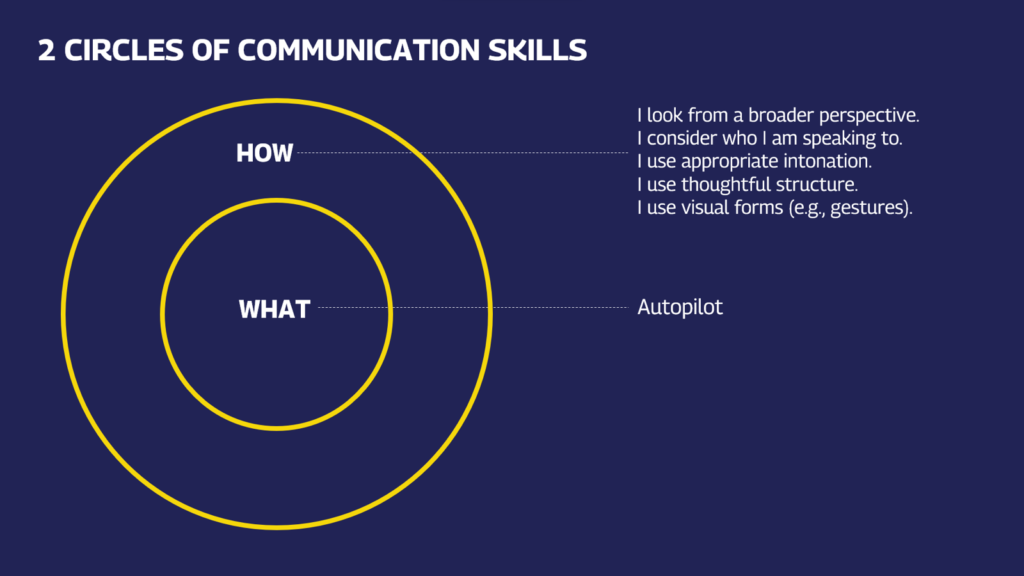What does mastery of communication involve? Is it about speaking beautifully? Is it about being persuasive? Or perhaps, is it about everyone listening to our words with great attention?
I argue that true mastery of communication is about moving from the enchanted circle of WHAT to the elite circle of HOW.
Let’s imagine an ordinary person, let’s say Anna. She has been working in the HR department for at least a few years and wants to enhance her communication skills. She wants to be a communication master. What advice could we give Anna to become such a master?
There could be plenty of suggestions because there is no one way to achieve any mastery. You need to practice, learn, read about it, undergo training, seek feedback, and so on. My most important advice, however, is as follows: step out of the enchanted circle of “WHAT to say” and rise to the level of “HOW to say.” From WHAT to HOW.
We can visualize these circles like this:

In my opinion, mastery of communication is precisely about transitioning from the circle of WHAT to the circle of HOW.
The WHAT circle has a narrowed perspective, limited insight into matters.
On the other hand, the HOW circle has a broad perspective. These are individuals who are aware not only of what needs to be said but also of which words to choose for a specific audience. They are aware of what a person might need, what their expectations and preferences are. They are aware that the circumstances of communication matter and adjust accordingly. They are conscious of the context and can relate to it, thereby building a better relationship with the interlocutor. They are aware that the same thing can be said in many different ways and choose consciously, selecting the one that best fits the situation.
Yes, the HOW circle consists of individuals who are communicatively conscious.
If Anna wants to become a communication master, she should start looking at communication from a much broader perspective. She should view her conversations from the side and assess their quality, analyze how everything could be said differently, better, in a way more tailored to the recipient, context, and situation. Looking from a broader perspective provides more communication options, and among them, we can choose the best ones.
Someone might say: does this not lead to excessive analysis and communication paralysis?
Yes, it may lead—only in the case of inexperienced individuals. If, however, we are talking about someone aspiring to be called a communication master, I assume that such a person is already experienced and can bear the burden of self-analysis. Indeed, real-time self-analysis during a conversation can be challenging.
But who said that achieving mastery is easy?
So, my main idea in this post is to encourage you to break free from autopilot mode. The autopilot mode operates in the internal circle of WHAT—where we only consider what to say, write, or communicate.
Let’s step out of that circle.
Let’s look at things more broadly. Let’s examine our way of speaking. Let’s consider whether what we say and how we say it is appropriate for this specific situation. Let’s ponder whether there is an alternative way to say the same thing, but differently. Maybe not necessarily by presenting seemingly unquestionable arguments, but perhaps by recounting a real-life story confirming our thesis?
Or maybe by citing statistical data with precise references to a credible source? Or by drawing an analogy to a familiar situation for both sides? Or by showing the recipient something—giving them something to hold in their hands, so they can see with their own eyes and touch with their own hands that what we are saying is true?
There are various ways of informing, persuading, and inspiring. Let’s be aware that the best ways may not be the ones that come to our minds first.
And if we have such an attitude, we will quickly build something I call our own communication repertoire. A repertoire, or a toolbox, from which we will pull out various communication techniques. Just like a carpenter sometimes uses a lever, sometimes a hammer, and sometimes a saw. He has a lot of tools in his toolbox.
And you, how many communication tools do you have in your toolbox? Do you know their names? Can you use them consciously?
If you answered NO to the above questions, it’s a sign that you are still operating in the WHAT circle, not the HOW circle.
But don’t worry. Rome wasn’t built in a day.
The awareness that we are functioning in the WHAT circle is valuable in itself. Because such awareness means you are at the stage of conscious incompetence. That’s already much better than being at the stage of unconscious incompetence.
Based on this foundation, we can continue working.

